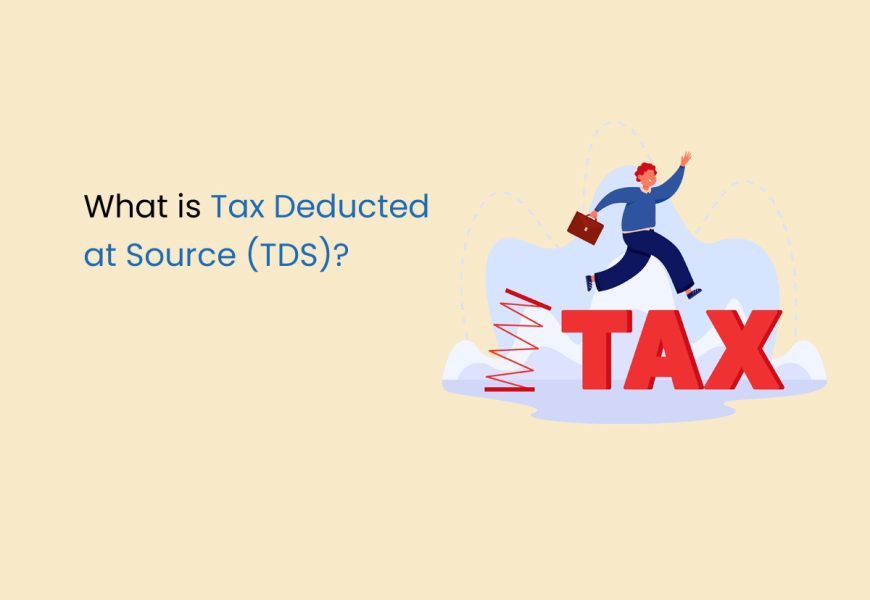TDS, or Tax Deducted at Source, refers to the amount deducted by an employer from an individual’s income, which is then remitted to the Income Tax Department on the individual’s behalf. This deduction is a predetermined percentage of the individual’s monthly income and is applied at the time of payment.
In accordance with the Income Tax Act of 1961, both individuals and organisations are obligated to pay taxes if their income surpasses a specified threshold. TDS serves as a mechanism to ensure timely tax collection and compliance with tax regulations.
Understanding TDS is crucial for employers and employees to navigate the tax landscape effectively. In this article, we delve into the key aspects of TDS, its significance, and the implications for taxpayers and organisations.
What is Tax Deducted at Source (TDS)?
Tax Deducted at Source (TDS) is a preemptive measure implemented by the government to regulate income tax payments. It involves deducting a portion of specified payments, including rent, commission, professional fees, salary, and interest, at the source itself. This ensures that the individual receiving the income is not burdened with the entirety of the income tax liability. The net amount is disbursed to the recipient, who later incorporates the gross amount into their income. The TDS amount withheld is then adjusted against the final tax liability during the tax settlement process. This mechanism allows the recipient to claim credit for the amount already deducted and remitted on their behalf.
Latest Updates
- In the Fiscal Year 2023-24 Union Budget, Finance Minister Nirmala Sitharaman unveiled a significant measure pertaining to dividend payments to Real Estate Investment Trusts (REITs) and Infrastructure Investment Trusts (InvITs). The announcement highlighted the exemption of Tax Deduction at Source (TDS) on dividend payments to these entities, with the overarching objective of enhancing adherence to tax regulations. Additionally, a proposal was introduced to shift the advance tax liability on dividend income to occur subsequent to the payment or declaration of the dividend. This strategic move would streamline tax processes and foster greater compliance within the investment landscape.
- The new Income Tax rule, outlined in Section 194N of the Income Tax Act 1961, stipulates that cash withdrawals from a bank or post office exceeding Rs.20 lakh will attract a TDS (Tax Deducted at Source) of 2.00%. This deduction applies if no Income Tax Return has been filed for the last three assessment years. Additionally, TDS will be levied on cash withdrawals exceeding Rs.1 crore in a year, provided that the taxpayer has filed ITR for all assessment years or any of the past three years. For cooperative societies, the TDS threshold increases from Rs.1 crore to Rs.3 crore.
- No TDS will be imposed on the interest earned from the Mahila Samman Certificate, as per the notification from the Central Board of Direct Taxes (CBDT). The interest earned under this scheme will be taxed based on the recipient’s applicable tax slab. The scheme offers an annual interest rate of 7.50% for a maximum deposit of Rs.2 lakh, and TDS will not be applicable if the interest earned does not exceed Rs.40,000 for the current fiscal year.
- To claim tax benefits under Section 80G for charitable donations, individuals must now submit a TDS-like certificate obtained from the Income Tax Portal. This certificate, downloadable from the income tax department’s e-filing portal, should be provided by the donee institution or NGO to which the donation was made.
Example of TDS
Shine Pvt Ltd, diligently managing its office space, pays the property owner a monthly rent of Rs 80,000. Now, here’s where TDS steps in – it’s like a tax checkpoint. Shine Pvt Ltd is required to deduct 10%, so they slice off Rs 8,000 and hand over the remaining Rs 72,000 to the property owner. The owner, on the receiving end, gets the net amount after TDS. Later, when the tax season rolls around, the property owner factors in the full Rs 80,000 as income but claims credit for the Rs 8,000 already deducted by Shine Pvt Ltd. It’s a mechanism that keeps things fair and square for everyone involved.
When is TDS Deducted, and Who Deducts It?
When making payments specified under the Income Tax Act, Tax Deduction at Source (TDS) is applicable. However, individuals or Hindu Undivided Families (HUFs) without auditable books are exempt from TDS. For rent payments exceeding Rs. 50,000 by an individual or HUF member, a 5% TDS is applicable, irrespective of the audit requirement. No Tax Deduction Account Number (TAN) is needed for this 5% deduction.
Working professionals have TDS deducted by employers based on income tax slab rates. Banks deduct TDS at 10%, or 20% without PAN details. TDS rates are defined in the Income Tax Act, and payers adhere to these rates.
Provided investment proofs are submitted to the employer and taxable income is below the threshold, no tax or TDS is deducted. Form 15G and Form 15H can be submitted to the bank if taxable income is below the limit, preventing TDS deduction on interest income.
In cases where investment proofs are not submitted and TDS is deducted by the bank, filing a return and claiming a refund is possible if the total taxable income remains below the limit.
For a comprehensive list of specified payments eligible for TDS deduction and respective rates, refer to the Income Tax Act.
What are TDS Rates on Salary?
TDS rates on salary align with the applicable tax slab rates for individuals. For individuals below 60 years of age, no TDS is levied if their income is less than Rs.2.5 lakh. Those earning between Rs.2.5 lakh and Rs.5 lakh are subject to a 5% TDS, while individuals with incomes between Rs.5 lakh and Rs.10 lakh face a TDS liability of 20%. Those earning above Rs.10 lakh are subject to a TDS rate of 30%.
Under the new tax regime, no TDS is required for annual incomes up to Rs.2.5 lakh. For incomes between Rs.2.5 lakh and Rs.5 lakh, the TDS liability is 5%. The TDS rates then increase progressively with income levels: 10% for incomes between Rs.5 lakh and Rs.7.5 lakh, 15% for incomes between Rs.7.5 lakh and Rs.10 lakh, 20% for incomes between Rs.10 lakh and Rs.12.5 lakh, 25% for incomes between Rs.12.5 lakh and Rs.15 lakh, and 30% for incomes exceeding Rs.15 lakh.
How to File TDS Return Online?
To successfully file your TDS return, it is crucial to adhere to the following steps:
- Obtain a valid Tax Deduction and Collection Account Number (TAN) and ensure it is registered for e-filing.
- Prepare your TDS statements using Return Preparation Utility and subsequently validate them using File Validation Utility.
- If you choose to upload your returns using a Digital Signature Certificate (DSC), make sure you possess a valid DSC registered for e-filing.
- Provide the demat account or bank account details of your principal contact. Alternatively, ensure that their PAN is linked with Aadhaar if you opt for uploading returns using the Electronic Verification Code (EVC).
Filing TDS Returns: Essential Guidelines and Timing
It is obligatory for individuals deducting Tax Deducted at Source (TDS) to file quarterly TDS returns. Key details must be provided, such as TAN, deducted TDS amount, payment type, PAN of deductee, etc. Different return forms, such as Form 26Q for all payments except salaries, are designated based on the purpose of TDS deduction. The filing deadlines for each quarter are
- Q1 – July 31
- Q2 – October 31
- Q3 – January 31
- Q4 – May 31.
Meeting the Government Deadline
To ensure timely compliance, TDS must be deposited to the government by the 7th of the following month. For instance, if TDS is deducted in June, the payment is due by July 7th. However, for March deductions, the deposit window extends till April 30th. Notably, TDS on rent and property purchases comes with a 30-day leeway, allowing payment until 30 days from the month-end, in which TDS is deducted.
Late Filing of TDS Returns
There are multiple penalties levied for failing to file your TDS return statements. They are as follows:
Failure to Submit Returns
Under Section 272A (2) of the Income Tax Act, a penalty is imposed for the failure to submit TDS returns. This penalty amounts to Rs.100 for each day that the returns remain unsubmitted, with a maximum penalty equivalent to the TDS amount.
Failure to File Returns on Time
In accordance with Section 234E of the Income Tax Act, a penalty is levied for delays in filing TDS returns. The penalty stands at Rs.200 for each day that the returns remain unfiled, with the maximum penalty capped at the TDS amount.
Defaults in Filing TDS Statement
Section 271H of the Income Tax Act addresses defaults in the filing of TDS statements. For failure to file the TDS return within the stipulated due date, a penalty ranging from Rs.10,000 to Rs.1 lakh may be imposed.
Incorrect Details in TDS Statement
Under the provisions of Section 271H of the Income Tax Act, a penalty ranging from Rs.10,000 to Rs.1 lakh is applicable in cases where the deductor submits incorrect information concerning PAN, challan particulars, TDS amount, and other related details.
Non-payment of TDS
Section 201A of the Income Tax Act deals with the non-payment of TDS. In addition to a penalty, interest is charged when TDS is not paid within the prescribed due date. If either a portion or the entire TDS amount is not deducted at source, interest accrues at a rate of 1.5% per month, calculated from the date on which the tax was deductible to the date when it is actually deducted.
How to Check TDS Deduction Status
There is a straightforward process for this:
- Begin the process by navigating to the official website of the Income Tax Department.
- Enter your relevant details and log in to the portal using the provided credentials.
- Navigate to the ‘My Accounts’ section and click on ‘view Form 26AS (Tax Credit)’.
- Choose the relevant assessment year and opt for the PDF format to download the file.
- The downloaded PDF file is password-protected. Decrypt it using the password, which is typically the date of birth mentioned on your PAN. For instance, if your date of birth is 5th March 2000, the password will be 05032000.
- Upon decryption, you can access and review all the details pertaining to TDS deductions in the downloaded file.
- For an alternative method, utilise your bank’s net banking facility to verify whether TDS has been deducted. Ensure that your PAN is linked to your bank account for seamless verification.
Understanding TDS Certificates
TDS certificates come in two forms: Form 16 and Form 16A. As per Section 203 of the Income Tax Act, 1961, a certificate must be issued to the deductee, reflecting the deducted tax amount. The responsibility of providing this certificate lies with the deductor.
Form 16 for Salaried Employees
For the salaried class, employers are mandated to furnish Form 16 to their employees. This form outlines the deducted TDS amount along with a comprehensive breakdown of tax computation and payment details. Employers are required to issue Form 16 to their employees by May 31 of the subsequent financial year.
Form 16A for Non-Salaried Individuals
In the case of non-salaried individuals, the deductor issues Form 16A to the deductee. This form encompasses detailed information regarding tax computation, TDS deduction, and associated payments. It serves as a comprehensive document for non-salaried individuals to track their tax-related transactions.
TDS Credits and Form 26AS
Understanding the connection between TDS and your PAN is crucial. TDS deductions, both for the deductor and deductee, are linked to PAN numbers. Form 26AS, a consolidated tax statement available to all PAN holders, plays a pivotal role. This form provides a detailed summary of TDS deducted on various income sources, such as salaries or interest income, associated with your PAN.
As PAN is intricately linked to TDS, accurately mentioning your PAN wherever applicable becomes imperative. Form 26AS not only covers TDS details but also includes income tax paid directly by you, be it as adva
Uploading TDS Statements
Ensure a smooth process for uploading TDS statements with the following steps:
- Visit the Income Tax Department website.
- Log in using your TAN credentials.
- On the dashboard, navigate to e-File > Income Tax Forms > File Income Tax Forms.
- Choose the appropriate form and complete the required details.
- Validate the return using either a Digital Signature Certificate (DSC) or Electronic Verification Code (EVC).
Common Types of TDS Deductions
Explore various income sources subject to Tax Deducted at Source (TDS):
- Salary: Deductions made from employee salaries.
- Payments to Contractors: TDS on payments for services by contractors.
- Commission Payments: TDS on commission earnings.
- Sale of House: TDS on the sale of property.
- Insurance Commission: Deductions from insurance commission payments.
- Interest on Securities: TDS on interest income from securities.
- Other Interest Payments: TDS on interest, excluding securities.
- Rent Payment: Deductions from rental payments.
- Professional Fees: TDS on professional service fees.
- Online Gaming: TDS on winnings from online games.
- Game Winnings: TDS on winnings from lotteries, crosswords, cards, etc.
Enhanced Transparency Through SMS Alerts
Stay informed about your tax deductions! The income tax department, via SMS alerts from VK-ITDEFL, now notifies taxpayers about the TDS (Tax Deducted at Source) against their PAN (Permanent Account Number). These quarterly alerts detail TDS credited for income sources like salary and interest, accumulating in your Form 26AS for the respective financial year. Initiated by the Finance Ministry, this SMS service aims to boost transparency, aiding taxpayers in cross-verifying details with payslips and preventing TDS mismatches during income tax filing.
Tax Liability with TDS Deduction
When TDS is deducted from your income, it’s crucial to understand how it impacts your overall tax liability:
- Salary TDS Deduction: TDS on salary is based on the applicable income tax slab. For other income types, fixed TDS rates (ranging between 10% and 20%) are applied. Importantly, these rates are not linked to your total income.
- Calculation of Annual Income: Calculate your annual income by aggregating earnings from all sources.
- Actual Tax Liability: Your actual tax liability is determined based on the total taxable income, considering deductions and exemptions.
- Claiming TDS Credit: You can claim credit for TDS deducted on various receipts. This involves subtracting the TDS amount from your calculated tax liability.
- Filing Income Tax Return: Whether you have a balance to pay or are eligible for a refund, filing an income tax return is mandatory. This process ensures compliance with tax regulations.
FAQs on TDS
What is the current TDS rate?
The current TDS rate is 10%
How is TDS calculated?
Using a hypothetical example, if the estimated total taxable income for the financial year is ₹10,00,000, and the employment period is 12 months, the monthly TDS amount can be calculated as ₹10,00,000 X 30% / 12 = ₹25,000.
Is TDS refundable?
Yes, TDS is refundable. If an individual falls into a lower tax bracket, they can claim a refund for the excess amount deducted. Additionally, a TDS refund can be claimed for any extra deduction on salary due to non-submission of investment proofs or rent receipts for house rent allowance.
What is the Full Form of TDS?
TDS stands for Tax Deducted at Source.
Who is eligible for a TDS deduction?
Any person taxable on their income is eligible for a TDS deduction.
What is the use of the TDS challan?
TDS challan is primarily used for depositing the tax deducted at source (TDS) with the government.
Is TDS required to be paid only by salaried individuals?
No, any individual with an annual income exceeding Rs.2.5 lakh is required to pay taxes, making TDS applicable to both salaried and self-employed individuals.
Is PAN required for payment of TDS?
Yes, PAN details are necessary for the payment of TDS.
What is the penalty if an employer fails to submit the returns within the due date?
A penalty ranging from Rs.10,000 to Rs.1 lakh will be levied under Section 271H.
What is the penalty for a company that fails to deduct TDS on time?
Under Section 201A, interest at a rate of 1% per month will be charged from the deduction date to the date on which the TDS was deducted.





















